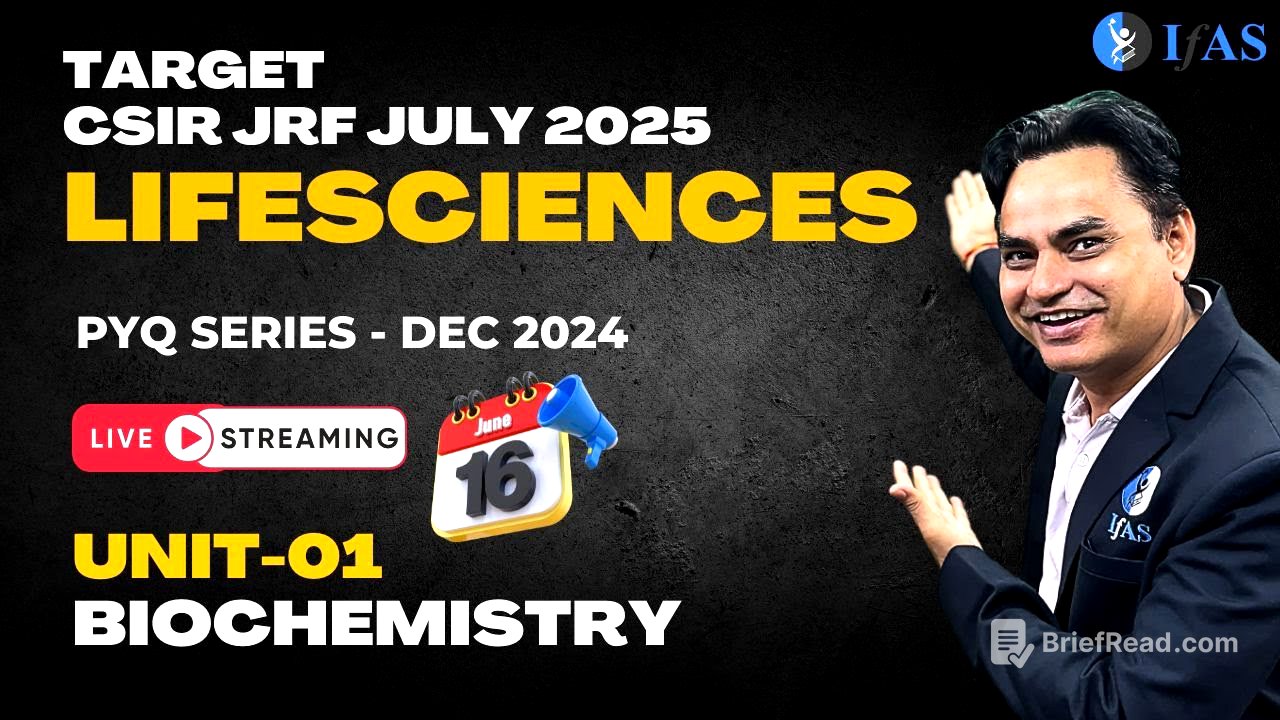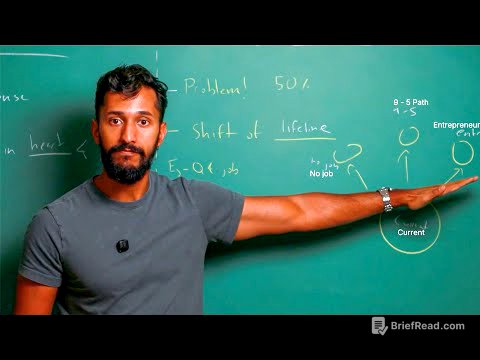TLDR;
This video provides a comprehensive review of key biochemistry concepts relevant to the CSIR, UGC, DBT, GATE, and SET exams. It covers molecular interactions, including covalent and non-covalent bonds, and delves into the specifics of electrostatic interactions, hydrogen bonds, hydrophobic interactions, and Van der Waals forces. The lecture also addresses pH calculations, acid dissociation constants (pKa), peptide bonds, protein secondary structures, enzyme kinetics, glycolysis, fatty acid oxidation, and amino acid biosynthesis.
- Molecular interactions and their significance in biological systems.
- Calculation and importance of pH and pKa values.
- Enzyme kinetics, glycolysis, beta-oxidation, and amino acid biosynthesis.
Greetings and Session Overview [0:11]
The instructor welcomes the students and expresses regret for the short notice regarding the session's timing. The session focuses on discussing important concepts in biochemistry through previous year's questions (PYQs) from the December 2024 exams. The goal is to help students understand the concepts and apply them to solve problems, aiming for at least two Part C questions from each unit.
Course Information and Book Introduction [5:59]
The instructor announces the start of a crash course and genetics class, and promotes a test series with a 70% discount. The instructor also introduces a pointer book for exam mapping, available for pre-booking and dispatch, assuring its benefits for the upcoming exam.
Molecular Interactions: Covalent and Non-Covalent Bonds [8:50]
Molecular interactions are divided into covalent and non-covalent bonds. Covalent bonds, formed by sharing electrons, stabilize the primary structure of biomolecules, such as peptide bonds in proteins and glycosidic bonds in sugars. Non-covalent interactions, including electrostatic interactions, hydrogen bonds, and hydrophobic interactions, are weaker but crucial in biological systems.
Electrostatic Interactions [10:11]
Electrostatic interactions involve attraction between opposite charges and repulsion between like charges. Examples include DNA and histone proteins, enzymes and substrates, and peripheral membrane proteins and lipids. These interactions are essential for molecular recognition and binding.
Hydrogen Bonds [12:32]
Hydrogen bonds form between a hydrogen atom and an electronegative atom, acting as a hydrogen donor and acceptor. They are vital for water's liquid state, DNA's double-stranded structure (A-T and G-C pairing), RNA's secondary structures, and interactions between biological membranes and proteins.
Hydrophobic Interactions [14:06]
Hydrophobic interactions occur between non-polar molecules in water, leading to aggregation to exclude water. This increases water's entropy, making the process favorable. Examples include lipid bilayers, where non-polar tails interact, and protein folding, where hydrophobic interactions drive the formation of tertiary structures.
Van der Waals Interactions [15:19]
Van der Waals interactions are the weakest, occurring between any two non-bonded atoms. They involve induced dipoles and are distance-dependent. Attraction increases as atoms get closer, but repulsion occurs if they get too close due to overlapping electron shells.
PYQ 1: Primary Stability of Nucleosomes [17:19]
The primary stability of nucleosomes is due to electrostatic interactions between the negatively charged DNA phosphate backbone and the positively charged lysine residues of histones. While hydrogen bonding, Van der Waals interactions, and hydrophobic interactions also play a role, electrostatic interactions are dominant.
PYQ 2: Self-Sealing Nature of Lipid Bilayers [20:03]
The self-sealing nature of lipid bilayers is due to the amphipathic character of lipids, hydrophobic interactions between tails, and hydrogen bonding with water molecules. Covalent interactions within lipid molecules are not responsible for this property.
PYQ 3: Triple Helical Structure of Collagen [21:45]
The triple helical structure of collagen is supported by hydrogen bonds between the polypeptide strands. These non-covalent interactions are secondary to the protein structure and stabilize the collagen helix.
Understanding pH Calculations [22:45]
The lecture explains how to calculate pH using the formula pH = -log[H+]. It emphasizes that when mixing two solutions of different pH, one should not directly average the pH values. Instead, convert pH to [H+], calculate the average [H+], and then convert back to pH. The formula [H+] = antilog(-pH) is used for these conversions.
Calculating pH Changes with Added Molecules [24:37]
The instructor describes how to determine the concentration of a molecule based on the pH change it induces in a solution. By calculating the initial and final [H+] concentrations, the change in [H+] can be determined, which corresponds to the concentration of the added molecule.
PYQ: Acetylcholine Concentration Calculation [27:19]
This section presents a problem involving the calculation of acetylcholine concentration in a solution based on pH changes caused by its breakdown. The initial and final pH values are used to find the change in [H+], which is then used to calculate the concentration of acetylcholine in moles per liter and subsequently in 15 ml.
Understanding pKa and Acidic/Basic Properties [31:59]
pKa is defined as the negative log of the acid dissociation constant (Ka) and indicates acid strength. A lower pKa means a stronger acid. The pKa value depends on the number of acidic groups in a molecule. Amino acids have at least two pKa values, one for the alpha carboxylic group (ranging from 1.7 to 2.4) and one for the alpha amino group (ranging from 8.8 to 10.6).
pKa Values of Amino Acid Side Chains [34:51]
The pKa values of amino acid side chains are discussed, including aspartic acid (3.65), glutamic acid (4.25), histidine (6), cysteine (8.33), tyrosine (10.07), lysine (10.53), and arginine (12.48). Histidine is highlighted as the only amino acid that can act as a buffer around physiological pH.
Mnemonic for pKa Order and Batch Information [37:05]
A mnemonic "D E H C Y K R S T" is introduced to remember the order of pKa values for acidic and basic amino acids. The instructor also mentions a new batch starting for those targeting the December exam and addresses queries about contacting the instructor for guidance.
PYQ: Arranging pKa Values of Amino Acid Side Chains [39:52]
The task is to arrange the pKa values of side chains in ascending order: aspartate, histidine, lysine, and serine. The correct order is determined based on the known pKa values of these amino acids.
Peptide Bonds: Formation and Properties [41:03]
Peptide bonds form between the alpha carboxylic group and the alpha amino group of amino acids, catalyzed by peptidyl transferase. These bonds have partial double bond character, are generally in trans configuration (except proline), and are planar. They participate in hydrogen bonding and absorb UV light at 190-220 nm.
PYQ: Nucleophilic Attack in Protein Synthesis [45:41]
In protein synthesis, the nucleophile for the reaction is the amino group, which attacks the carboxylic group. This holds true regardless of whether the synthesis proceeds from the N-terminus to the C-terminus or vice versa.
Properties of Amino Acids [46:49]
Acidic amino acids (aspartic acid, glutamic acid) are polar and negatively charged. Basic amino acids (lysine, arginine, histidine) are polar and positively charged. Branched-chain amino acids (valine, leucine, isoleucine) are non-polar and hydrophobic. Aromatic amino acids (phenylalanine, tryptophan, tyrosine) can be polar or non-polar. Proline is non-polar and produces steric hindrance. Sulfur-containing amino acids (cysteine, methionine) generally do not produce steric hindrance.
PYQ: Mutation and Protein Precipitation [52:36]
A cytoplasmic monomeric protein containing a single non-surface exposed cysteine is considered. Mutation of cysteine to isoleucine leads to precipitation, while mutation to alanine results in a soluble protein. The correct answer is that cysteine mutated to isoleucine causes steric hindrance in the core of the protein, while mutation to alanine does not.
Supersecondary Structures (Motifs) [55:02]
Supersecondary structures or motifs are combinations of secondary structures. Examples include helix-turn-helix motifs, hairpins, and Greek key motifs. Motifs are related to secondary structures but less so to tertiary structures. Anti-parallel beta sheets form shorter motifs due to straight turns, while parallel beta sheets require longer, flexible regions.
PYQ: Arranging Motifs by Length [58:32]
The task is to arrange motifs by length. The length depends on how the N-terminal and C-terminal are connected. Motifs with anti-parallel beta sheets are shorter, while those with parallel beta sheets are longer due to the need for larger loops.
CD Spectroscopy [1:02:06]
CD spectroscopy in the far UV range (180-250 nm) is used to analyze protein secondary structures. Different secondary structures have varying orientations of peptide bonds, leading to different absorption patterns. Alpha helices show a positive peak around 190 nm and two negative peaks around 208 nm and 222 nm. Beta sheets show a positive peak around 192 nm and a negative peak around 218 nm. Random coils show a reversal of the beta sheet pattern.
PYQ: Interpreting CD Spectra [1:07:41]
The CD spectrum does not resemble classical secondary structures, indicating a mixture of more than one secondary structure. The region from 250 to 330 nm provides information about the tertiary structure.
Sugar Puckering [1:11:10]
Sugar puckering involves the non-planar structure of sugar in nucleotides. Sugar adopts a half-chair conformation, with one atom outside the ring. Endo conformation occurs when the ring atom is on the same side as C5, while Exo conformation occurs when it is on the opposite side. C2 endo is present in B-form DNA, while C3 endo is present in A-form DNA.
PYQ: Matching Sugar Pucker Diagrams [1:15:55]
The task is to match sugar pucker diagrams with their descriptions. The key is to identify whether the second or third carbon is raised upwards (endo) or pulled downwards (exo).
DNA Forms: A, B, and Z [1:18:08]
A-form and B-form DNA are right-handed, while Z-form is left-handed. A-form has 11 base pairs per helix, B-form has 10.5, and Z-form has 12. Sugar puckering is C3 endo in A-form and C2 endo in B-form. Major grooves are narrow and deep in A-form, wide and intermediate in B-form, and shallow and flat in Z-form.
PYQ: Matching DNA Properties to Forms [1:19:35]
The task is to match properties to DNA forms: left-handed (Z-form), 10 base pairs (B-form), and RNA double helix (A-form).
Gibbs Free Energy [1:21:49]
Gibbs free energy (ΔG) is the energy available to do work. The formula is ΔG0 = -RT ln Keq. In biological conditions, ΔG = ΔG0 + RT ln(B/A), where B and A are cellular concentrations of products and reactants.
PYQ: Calculating ΔG0 and Keq [1:25:11]
The task is to calculate ΔG0 and Keq given the concentrations of reactants and products at equilibrium. The formulas ΔG0 = -RT ln Keq and Keq = [Products]/[Reactants] are used.
PYQ: Temperature Dependence of Keq [1:27:11]
If ΔG0 for a reaction shows no change with temperature, the relationship between Keq and temperature is Keq = c * e^(1/T), where c is a temperature-independent constant.
Enzyme Properties [1:29:37]
Enzymes participate in reactions without being consumed, are substrate-specific and stereospecific, and increase reaction rates by lowering activation energy. They work at optimum pH and temperature, and do not affect the equilibrium constant (Keq) or Gibbs free energy (ΔG0).
PYQ: Enzyme Effects on Forward and Reverse Reactions [1:32:32]
Enzymes increase both forward and reverse reaction rates equally, without affecting the equilibrium constant.
Enzyme Kinetics: Michaelis-Menten [1:33:26]
Enzyme kinetics involves the relationship between substrate concentration and reaction velocity. The Michaelis-Menten equation is v0 = (vmax * [S]) / (Km + [S]). Km is the substrate concentration required to achieve half of Vmax. Vmax depends on the enzyme's speed (Kcat) and total enzyme concentration.
PYQ: Substrate Concentration for 1/4 Vmax [1:37:19]
The task is to find the substrate concentration required for the reaction velocity to be one-quarter of its maximum (Vmax/4). Using the Michaelis-Menten equation, it is determined that the substrate concentration must be Km/3.
Reversible Inhibitors [1:40:02]
Reversible inhibitors bind temporarily to enzymes. Competitive inhibitors increase Km, non-competitive inhibitors decrease Vmax, and mixed inhibitors affect both Km and Vmax. Alpha is the factor by which Km and Vmax change. Ki (inhibitor constant) can be calculated using the formula Ki = [I] / (α - 1).
PYQ: Calculating Ki from a Graph [1:43:52]
The task is to calculate Ki given the inhibitor concentration and the change in Vmax from a graph. The formula Ki = [I] / (α - 1) is used, where α is the factor by which Vmax changes.
Glycolysis [1:45:10]
Glycolysis involves the breakdown of glucose into pyruvate, producing ATP and NADH. In aerobic conditions, pyruvate is further processed, while in anaerobic conditions, it is converted to lactate or ethanol. Fermentation recycles NADH back to NAD to allow glycolysis to continue. Regulatory steps involve hexokinase, phosphofructokinase-1, and pyruvate kinase.
PYQ: Purpose of Lactate Conversion in Anaerobic Respiration [1:50:13]
Skeletal muscle cells convert pyruvate to lactate during anaerobic respiration to regenerate NAD+, which is essential for glycolysis to continue producing ATP.
Citric Acid Cycle (TCA Cycle) [1:51:01]
The TCA cycle involves a series of oxidative reactions in the mitochondria, producing ATP, NADH, and FADH2. Regulatory steps involve citrate synthase, isocitrate dehydrogenase, and α-ketoglutarate dehydrogenase. The cycle operates only in aerobic conditions because it requires NAD+ and FAD, which are regenerated by the electron transport chain.
Fatty Acid Oxidation (Beta-Oxidation) [1:55:17]
Beta-oxidation involves the breakdown of fatty acids in the mitochondria (animals) or peroxisomes (plants). Fatty acids are activated by converting them to fatty acyl-CoA, transported into mitochondria as acyl-carnitine, and then oxidized. The process involves oxidation, hydration, and thiolysis, producing acetyl-CoA.
PYQ: Beta-Oxidation Statements [1:57:22]
The correct statement regarding beta-oxidation of fatty acids is that fatty acids are oxidized at the C3 position to remove a two-carbon unit.
Amino Acid Biosynthesis [1:58:07]
Amino acids are synthesized from various precursors: serine, glycine, and cysteine from 3-phosphoglycerate; alanine, leucine, isoleucine, and valine from pyruvate; glutamate, glutamine, proline, and arginine from α-ketoglutarate; aspartate, asparagine, lysine, methionine, and threonine from oxaloacetate; and histidine from ribose-5-phosphate.
PYQ: Matching Amino Acids to Precursors [1:59:44]
The task is to match amino acids to their precursors: serine, glycine, and cysteine from 3-phosphoglycerate; alanine, valine, and leucine from pyruvate; glutamate, glutamine, and proline from α-ketoglutarate; and lysine, methionine, and threonine from aspartate.
Closing Remarks [2:02:01]
The instructor concludes the session, reminding students about the upcoming class at 8:00 AM and promoting the exam mapping books.









